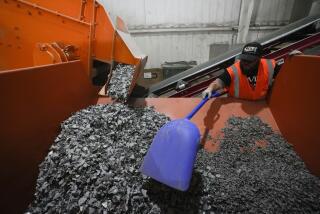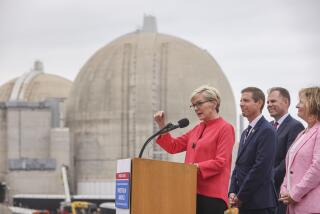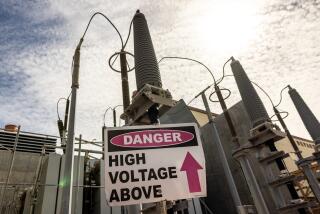Florida Trash May Be Gone in a Flash
- Share via
FORT PIERCE, Fla. — A Florida county plans to ditch its dump, generate electricity and help build roads -- all by vaporizing garbage at temperatures hotter than parts of the sun.
The $425-million facility expected to be built in St. Lucie County would use lightning-like plasma arcs to turn trash into gas and rock-hard material. It would be the first such plant in the nation and the largest in the world.
Supporters say the process is cleaner than traditional trash incineration, though skeptics question whether the technology can meet the lofty expectations.
The 100,000-square-foot plant, slated to be operational in two years, is expected to vaporize 3,000 tons of garbage a day. County officials estimate that their landfill, which holds 4.3 million tons of trash collected since 1978, will be gone in 18 years.
No byproduct will go unused, according to Geoplasma, the Atlanta-based company building and paying for the plant.
Synthetic, combustible gas produced in the process will be used to run turbines to create electricity -- about 120 megawatts a day -- that will be sold back to the grid. The facility will operate on about a third of the power it generates, free from outside electricity.
About 80,000 pounds of steam per day will be sold to a neighboring Tropicana Products Inc. facility to power the juice plant’s turbines.
Sludge from the county’s wastewater treatment plant will be vaporized, and a material created from melted organic matter -- up to 600 tons a day -- will be hardened into slag and sold for use in road and construction projects.
For years, some waste-management facilities have been converting methane -- created by rotting trash in landfills -- to power. Others also burn trash to produce electricity.
Experts say population growth will limit space available for future landfills.
The plasma-arc gasification facility in St. Lucie County, on central Florida’s Atlantic Coast, aims to solve that problem by eliminating the need for a landfill. Only two similar facilities are operating in the world -- both in Japan -- and are gasifying garbage on a much smaller scale.
No emissions are released during the closed-loop process, Geoplasma says. The only emissions will come from the synthetic gas-powered turbines that create electricity. Even that will be cleaner than burning coal or natural gas, experts say.
Few other toxics will be generated, if any at all, Geoplasma says.
But critics disagree.
“We’ve found projects similar to this being misrepresented all over the country,” said Monica Wilson of the Global Alliance for Incinerator Alternatives.
Wilson said there weren’t enough studies yet to prove the company’s claims that emissions would probably be less than from a standard natural-gas power plant.
She said other companies had tried to produce such results and failed. She cited two similar facilities run by different companies in Australia and Germany that closed after failing to meet emissions standards.
“I think this is the time for the residents of this county to start asking some tough questions,” Wilson said.
Louis Circeo, director of the Georgia Institute of Technology’s plasma research division, said criticism of the technology was based on a lack of understanding. “We are going to put emissions out, but the emissions are much lower than virtually any other process, especially a combustion process in an incinerator,” he said.
Circeo said both plants operating in Japan, where emissions standards are more stringent than in the U.S., were producing far less pollution than regulations allowed.
Geoplasma expects to recoup its $425-million investment, funded by bonds, within 20 years through the sale of electricity and slag.
“That’s the silver lining,” said Hilburn Hillestad, president of Geoplasma, adding that St. Lucie County won’t pay a dime.
More to Read
Sign up for Essential California
The most important California stories and recommendations in your inbox every morning.
You may occasionally receive promotional content from the Los Angeles Times.













